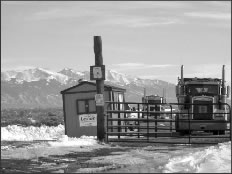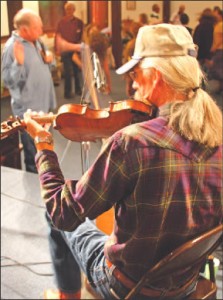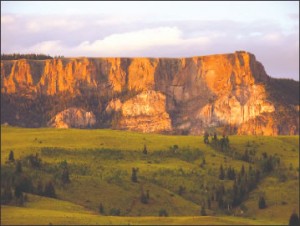Update on the Lexam drilling project
by David Bright
CRESTONE -The fight to stop Lexam Exploration, Inc. from drilling three 14,000 wells in the Baca Wildlife Refuge has been going on for over two and a half years. The most recent development is an agreement reached between Lexam, The U.S. Fish and Wildlife Service and the San Luis Valley Ecosystem that will give the organizations working on the issue more time to find a permanent solution. The agreement will be in place until August 1, 2009. It will “cease all construction activities on the Lexam Road” (a road owned by Lexam that crosses the refuge) and stop any other work on access roads and well pads from beginning.

Since the U.S. Fish and Wildlife Service determined from the Environmental Assessment that was released on January 8, 2008 that there would be “no significant impact” caused by Lexam drilling on the Baca Wildlife Refuge, legal action has delayed the company from beginning work. The legal action is to get an Environment Impact Study done. This is a more in-depth study that would take several years to complete.
Just before the most recent agreement was reached, in early March 2009, Lexam began work on the road that belongs to them and will be used to access the proposed drill sites. The company placed a guard shack at their gated entrance to wildlife refuge. To improve the road, they brought in four tractor trailer loads of gravel and used a motor grader to spread the gravel.
Lexam’s activity on the refuge has reminded the citizens of the San Luis Valley of how real the threat to their valley is. The Baca Wildlife Refuge is one of the few wildlife refuges in America that doesn’t own the mineral rights as well as the water and surface rights. The land for the refuge was purchased for $30 million which did not include the mineral rights, a decision opponents of the project have come to regret.
Many of those working to stop the drilling believe the answer is to get the federal government to purchase the mineral rights so the refuge can serve its intended purpose as stated in the Omnibus Public Land Management Act of 2009 (S.22) – “to restore, enhance, and maintain wetland, upland, riparian, and other habitats for native wildlife, plant, and fish species in the San Luis Valley.”
In fall of 2008 Rob McEwen, CEO of Lexam, was delivered a petition with over 20,000 signatures. The petition asked him to donate the mineral rights that Lexam owns to an organization to hold them in safe keeping so no drilling could occur on the refuge. In the forty-five minute conversation that ensued McEwen was asked if he would sell the mineral rights when he seemed unwilling to donate them. His answer was, “Make me an offer.” So, at this time there is a willing seller of the mineral rights. Opponents believe the next step is to convince the federal government that they should be a willing buyer, offsetting the problem caused by not buying them when the land was first purchased to create the refuge. They hope a new, more environmentally conscious administration might make this possible.
NHA designation sought for Valley
Congressional approval is being sought by a number of Valley residents to form a National Heritage Area (NHA). The group seeks designation of 3,237 square miles in Alamosa, Conejos and Costilla counties.
The designation would allow eligibility for funding by the U.S. Congress. NHA designation emphasizes the unique cultural, geographical and historical qualities of an area.
The Sangre de Cristo NHA steering committee is collecting letters of support from local individuals, organizations and government groups and will meet with state officials in June. A feasibility and suitability study is also in the works.
The NHA does not have the authority to hold lands so there is no property procurement in the designation.
To submit a letter of support, schedule a presentation on the Sangre de Cristo National Heritage Area or for more information please contact Ann Marie Velasquez at 580-6212 or Rick Manzanares at 379-3512.
SLV Briefs by Marcia Darnell
Water Irony
Brown stuff was coming out of the taps of some Alamosa homes, and after last year’s salmonella scare, everyone was paranoid. The ensuing investigation showed that the chemicals the city uses to treat the water reacted with the cast-iron pipes in the old sections of town, is creating the discoloration. The system will clear itself with time, say officials. Meanwhile, the city will get $500,000 in federal funds to rehab its water system.
When the Levee Breaks
The Army Corps of Engineers now says they fouled up. A decade ago the Corps built the levee that runs through Alamosa, protecting the town from the whims of the Rio Grande. Now they say the levee is weakened by the trees that were left along the dike. They also say any repairs to the levee will have to paid for by the city.
North of the city, consultants for the Alamosa Ranch told the city to maintain the ranch as open space until a strong proposal comes up for something else.
To the west, the developers of the proposed Village at Wolf Creek missed their January deadline with the U.S. Forest Service, and their Environmental Impact Statement process is dead.
Valley wide, Water Judge John Kuenhold accepted parts of the first groundwater management subdistrict plan, and sent others back to the subdistrict’s board for tweaking.
Mine Cuts
In the first big hit the Valley has taken from the recession, Hecla Mine in Questa, NM, has cut 230 jobs. It’s estimated that 50 of the mine’s workers live in the southern San Luis Valley, one of the poorest areas of the U.S.
In happier mining news, that same mining company is again exploring for silver near Creede.
Brief Briefs
• Someone alert Ed Quillen: Colorado Malting Company is open for business in Alamosa.
• Blanca is doing an economic assessment, and is looking for people interested in helping develop the town.
• The BLM is taking public comments on a restoration project at Elephant Rocks.
• The Alamosa Board of Education declined to sign a letter of support for SB 170, which would allow in-state college tuition for children of undocumented immigrants. The decision has created controversy in the community.
• Alamosa County saved $22,000 with mail-in balloting last election, according to County Clerk Melanie Woodward.
• San Luis Valley Regional Medical Center is installing a solar plant to increase its power usage.
• The El Pomar Foundation gave $185,000 to 26 deserving groups in the Valley.
• A bomb threat emptied two banks in Alamosa. No bombs were found.
• A medical clinic has been proposed for downtown Monte Vista. Public hearings are underway.
• Sewer rates are going up in Alamosa, for both residential and commercial flushers. The rates will double over three years.
• Mikie Husmann was named Youth of the Year by the Boys and Girls Clubs of Colorado.
• Mark Smith of Center was named to the Colorado Wildlife Commission. He was Field & Streams’s 2008 Hero of Conservation.
• The Adams State College budget is cut by over $500,000 for 2009. More cuts are planned for 2010.
• Victoria Bresee is the new associate dean of instruction/academic programs at Trinidad State Junior College – Valley Campus. Robert Alejo is the new superintendent of Alamosa Public schools, coming from the north Conejos district.
• Southern Peaks Public Library will publish a literary magazine. Writers of stories and poems are being sought.
• City Councilor Kathy Rogers threw her hat into the ring for the post of Alamosa’s mayor.




